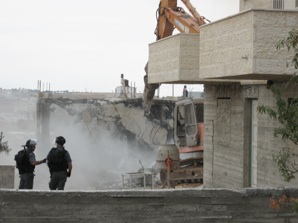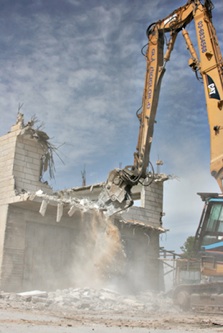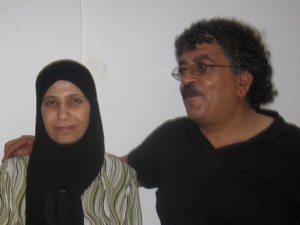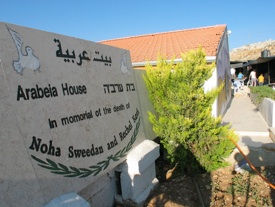House Demolition


Through contact with ICAHD (The Israeli Committee Against House Demolitions) we came to hear about (and see the results of) this one. In many ways house demolition feels like a continuing Nakba (the Palestinian word for the ‘catastrophe’ of 1948, in which people were expelled from their homes, becoming refugees, their houses frequently demolished). The displacement of people simply hasn’t ended. Demolition of Palestinian homes takes place both in Israel proper and in the occupied territories. Since the beginning of the occupation in 1967, Palestinian houses have been demolished, two or three at a time, to a tune of a total of more than 24,000; 30,000 Palestinians having been made homeless.
The grounds given for house demolitions are multifarious. What is clear is that, overwhelmingly, they do not take place on grounds of ‘security’ as the Israeli authorities will allege. Less that 8% could be placed in this category. The demolitions represent a concrete outworking of a strategy which aims to control Palestinians; confining them to crowded, impoverished and disconnected enclaves. Demolitions take place to clear land for settlements, for settler by-pass roads, the separation wall, and military installations. They may also serve as collective punishment with the aim of making life so unbearable for Palestinians that they will leave. Given that the homes of Jews are not demolished, demolition of Palestinian houses may be classed as ethnic cleansing. (See the description which Jeff Halper, the founder and head of ICAHD, gives of the impact that it made on him to witness the senseless demolition of the home of the Shawamreh family, who were to become his firm friends: An Israeli in Palestine.)
The situation - as I heard Salim Shawamreh rightly call it - is Kafkaesque. (Very much in parallel, one might say, with the conditions the Jews themselves experienced in the Third Reich: a plethora of rules and regulations designed to create a no-win situation.) Any house built after 1967 in the occupied territories without a permit is illegal. Permits are almost impossible to obtain. Salim recited a saga of arriving with his papers, being told he had a stamp missing, attempting again to do the right thing, only finally to be told that his papers were lost. Any house which it can be shown that one owned before 1967 one may keep, but it is forbidden to renovate a house without a permit. Permits are likewise well-nigh impossible to obtain. So no community can grow. 94% of applications to build are rejected.
The Oslo process divided up the West Bank into areas A, B and C, respectively under Palestinian, joint, and exclusively Israeli control. The map is so complex that (I heard) sometimes people won’t even know the designation of their area – and then will be told that they are in area C and that their house will be demolished. Or they built at the beginning of the Oslo process at a time when they understood that this was now going to be OK. There is a problem in the case of older houses; legal papers were issued in Ottoman times and are difficult to unearth. Further, in that era people often only registered part of their land because taxation was related to the extent of the land. They cannot now therefore validate that this land is theirs and it is taken away. To compound the problems, the documents were written in Turkish using Arabic script (in pre-Ataturk Turkey), which few can read these days. (Of course only Jews are allowed to reclaim property on account of a situation pertaining before 1948; no Palestinian could reclaim any of the hundreds of homes in West Jerusalem that belonged to them!)
Hence house papers come to hold untold value. I met one man who carried his with him everywhere.
Much of this demolition is taking place in Area C of the West Bank, the area entirely under Israeli jurisdiction. The authorities will come at night to check if people are actually living in the house that they claim they are. In East Jerusalem likewise a lot of houses have been declared illegal. I heard the following account. If your house is declared illegal it may be removed. If however you self-demolish your house it is not in the statistics and your fine is halved. If the Israelis have to send in a bulldozer and a helicopter to enforce the demolition then you have to pay $300K for these. Such a house costs approximately $150K to build. If you defy this then you go to jail. You may also be required to remove the rubble. If you don’t comply you may be fined for the rubble. The fines, and the costs for applying for permits are huge, if not unmanageable, for most Palestinians. People frequently rebuild (what else can they do?), their neighbours helping them. ICAHD has summer camps in which international volunteers and Israelis together with Palestinians rebuild demolished houses. The house may of course be demolished again. Beit Arabiya, the Shawamreh family home, has been demolished four times, most recently after having been rebuilt as a peace centre by such an ICAHD summer camp – such that it is much loved by many people. It has become something of a test case. When I was there (May 2009) they were anxiously awaiting the out-come of a Court process. Since returning I have learnt that the Israeli high court has ruled that it should be demolished again.
People will, often over years, be in the situation of not knowing if they will be among those whose houses have been declared illegal whose house will actually be demolished: random demolitions spread anxiety. When they get up in the morning they will first anxiously look out of the window and when they see no bulldozers get on with their day. The actual process of a house demolition is horrifying. The IDF will commonly arrive in the early hours of the morning, sending between 10 and 30 vehicles and maybe helicopters; which of course creates a situation of terror. Bulldozers, or machines with pneumatic drills, will smash the house. The soldiers may be on rooftops. If people resist they may be beaten, blindfolded and taken away. (I learnt all this in a UN centre. See further in Jeff Halper’s An Israeli in Palestine a description of what happened at Beit Arabiya, at which event he was present. Salim was tied up and thrown out of the house. When, in the commotion, his wife Arabiya succeeded in locking the door to protect their children, canisters of tear gas clearly marked ‘for outside use only’ were thrown through the windows, which lead to her being carried out unconscious. For some time afterwards she was unable to speak, while the children had other symptoms.)
In Israel itself between 1948 and into the 1960s , 531 Palestinian villages and 11 urban neighbourhoods (two thirds of the villages of that part of Palestinian territory which became Israel) were systematically demolished. Today entire Bedouin villages in the Negev with a population of 60-70K are threatened. Arabs are almost 20% of the population of Israel, but are confined by law and zoning policy to 3.5% of the land. In 95% of cases the residents in no way committed a security offence or illegal act and are not accused of doing so. ‘The Message of the Bulldozers is clear: “Get out. You do not belong here. We uprooted you from your homes in 1948 and prevented your return, and now we will uproot you from all the Land of Israel.”’ (Halper, Obstacles.) While there can be stays of execution, ICAHD is not aware of any house demolition order having been overturned. There has never been a demolition of a Jewish house either in Jerusalem or in the Occupied Territories.
Under the Fourth Geneva Convention (1949) it is enjoined upon Israel as an occupying power to protect and ensure the needs of the Palestinian populace. Human rights organizations are agreed that Israel’s policy of house demolition constitutes a war crime.The Gaza Community Mental Health Programme has found a strong correlation between house demolition and young people who become suicide bombers.

ICAHD
The dreaded bulldozer
Specialist Literature:
-
-Jeff Halper, ‘Demolishing Homes, Demolishing Families, Demolishing Peace’, Obstacles to Peace, Fourth Printing 2009.
-
-Meir Margalit, No Place Like Home: House Demolitions in East Jerusalem (ICAHD, March 2007.) Downloadable here.
-
-Amnesty International, ‘Under the Rubble: House Demolition and Destruction of Land and Property’, May 2004
-
-ICAHD-USA, House Demolition Primer,
Podcasts:





People walk round and round in circles with papers trying to get building permission
Arabiya and Salim Shawamreh
House being demolished
Mural on the wall of Beit Arabiya
Bulldozer is made in the USA
Palestinians, Israelis and the International Community march in unison. The slogan reads ‘No Wall Between ...’
ICAHD
East Jerusalem
At present the Israeli government is pursuing a policy of forcing Palestinian families out of their homes in East Jerusalem, handing these properties over to fanatical Jewish settlers who, protected by the army, are thus placed in the heart of Palestinian districts. The Israelis customarily move in through a strategy of a dot on the map here, a dot there, then filling in between the dots joining them together.
Six thousand Palestinian families in East Jerusalem potentially face the demolition of their homes. In Silwan at the time we were there (May 2009) (East Jerusalem) two homes had been demolished and one self-demolished. 88 houses were in danger with demolition orders on them. Since then there has been much more trouble in Silwan. In one incident a settler guard with assault rifle killed a man cold-bloodedly; in another a settler deliberately drove his car into two Palestinian boys, who were badly hurt.
There have been demonstrations by Israeli citizens in solidarity with Palestinians against demolitions. Many Palestinian homes in Jerusalem were of course earlier demolished when the area was cleared to make the concourse before the Wailing Wall.
Astonishingly, precisely at the time when the Obama Administration was trying to get peace negotiations underway in March 2010, it was announced by the Netanyahu government that a further 1,600 settler houses were to be built in East Jerusalem. In July 2010 ICAHD reported that there had been a sharp increase in demolitions, both in East Jerusalem and on the West Bank. ‘On 29 July at 2.00 a.m. settlers accompanied by private security forces seized the home of the Qerash families [in EJ] and erected barbed wire along the roofs of nearby properties.’ Most were away at a wedding. ‘Upon their return they were refused entry to their home by the Israeli police.’ (ICAHD website, Aug. 2010).
In early 2011 an urgent appeal was issued in relation to the arrest of children in Silwan. 76% report some form of violence during their arrest, transfer or interrogation. According to Israeli police figures in the twelve months ending October 2010, no less than 1,267 criminal files were opened against Palestinian children living in occupied East Jerusalem. (DCI e-mail, 8 Jan. 2011).
See Further on this Site:
‘While UN bodies have condemned these demolitions, absent actionable measures, the condemnations alone fall short of the United Nations' obligations to maintain peace and security and to ensure respect for human rights and fundamental freedoms. Under international law the State is obliged to prevent, investigate, and provide remedy, and when it fails to do so the international community becomes responsible for providing victims with effective protection. Violence by non-state actors (settlers) should not be seen merely as provocative actions; but as part of an overarching policy backed by State authority. By stopping at rhetoric, the United Nations, States, and international organizations fail to adequately respond to Israel’s human rights abuses that both fuel the humanitarian crisis and undermine the peace process. ....
Demolitions and the denial of basic human rights, such as shelter, are features of Israel’s apartheid regime and are indicative of the root causes of the ongoing humanitarian crises in the OPT. At best, Israel's recent demolitions can be considered attempts at colonization, at worst they can be interpreted as ethnic cleansing.
Taking these actions into account, one cannot help but be confused by the good faith underpinning the most recent calls for peace' talks. We call upon States, UN bodies, international organizations, and the international community at large to reconcile peace talks with humanitarian and human rights law in an effort to create an environment where peace may actually be sought instead of paying lip service to peace in the shadow of demolitions and displacement.’
(Press Release, Badil Resource Center, 19.08.2010)
